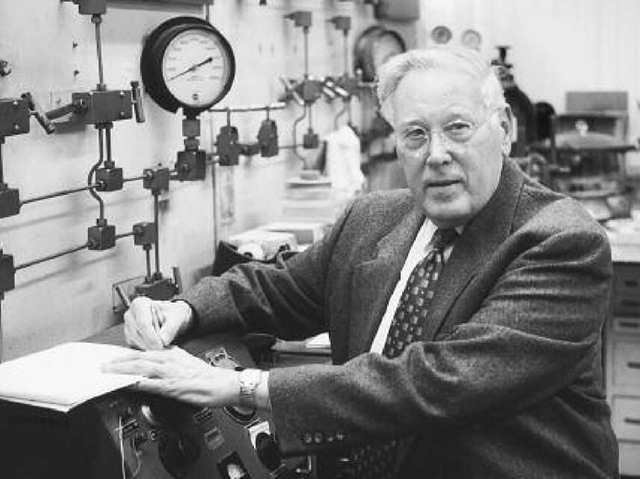(1921- ) American Petrologist, Geochemist
There are a few Earth scientists whose accomplishments are so numerous that they are difficult to fit in the allocated space of this topic and Hat-ten Yoder is one. He is among the most influential experimental mineralogists-petrologists in the history of the science. His early research involved the design and construction of an innovative high-pressure experimental apparatus that was unmatched in the world. He conducted experiments on metamorphic rocks and minerals that established whole new stability fields of metamorphism and quantified them. Indeed, through his experimental studies, he was able to quantify for the first time, the pressures and temperatures of various metamorphic isograds and grades. This work was far ahead of its time. Yoder’s book Geochemi-cal Transport and Kinetics and his paper “Thermo-dynamic Problems in Petrology” summarize much of this work.
Yoder’s other major area of interest is the origin of basalts. He produced the first quantitative study of the crystallization of basaltic magma by applying his experimental results. He also conducted experimental research on the origin of basaltic magma and developed elegant models that now appear in every textbook on physical geology not to mention igneous petrology. He developed a new model for the generation of contemporaneous bimodal volcan-ism in extensional plate tectonic settings. Even physical properties like viscosity of lavas were determined in Yoder’s lab. He edited the volume The Evolution of Igneous Rocks: Fiftieth Anniversary Perspectives (on norman l. bowen’s book) which itself was an instant classic.
There are many other areas of geology that Hatten Yoder has influenced, whether it is the development of the early atmosphere, experimental constraints on minerals leading to a mineral being named after him (yoderite), the formation of ore deposits or advising the U.S. Congress on natural resources and the environment. Each of these is a story in itself. However, one of Yoder’s main areas of interest is the history of geology. He has taken on the task to preserve the record of the historical development of Earth sciences through society work and publication. Many of the publications are biographies of people who worked with Yoder. Other publications preserve the history of classic geologists but there are also discussions on intellectual development of modern geology.
Hatten Yoder Jr. was born on March 20, 1921, in Cleveland, Ohio. He attended the University of Chicago, Illinois, where he earned an as sociate of arts degree in 1940, a bachelor of science in geology in 1941, and a certificate of proficiency in meteorology in 1942. He joined the U.S. Navy in 1942 and saw active duty during World War II until 1946, including the MOKO expedition to Siberia as a meteorological officer. He retired as a decorated lieutenant commander from the U.S. Naval Reserves after 16 years of service. He attended graduate school at the Massachusetts Institute of Technology and earned a Ph.D. in 1948. He accepted a position as a petrol-ogist at the Geophysical Laboratory of the Carnegie Institution of Washington, D.C., in 1948 and remained there for the rest of his career.
Hatten Yoder at work in his laboratory in the Geophysical Laboratory at the Carnegie Institution of Washington, D.C.
He served as director of the Geophysical Lab from 1971 until his retirement in 1986. He remains a director emeritus today. During his career, he was a visiting professor at California Institute of Technology, University of Texas, University of Colorado, and the University of Cape Town. Yoder married Elizabeth Bruffey in 1959 and they had two children. Mrs. Yoder passed away in 2001.
Hatten Yoder has had a very productive career. He is an author of some 103 articles in international journals, professional volumes, and governmental reports, as well as book reviews, forewords, and entries. Many of these articles are benchmarks in mineralogy, petrology, and geochemistry. He is also the author of some 25 biographies of prominent geologists.His research as well as his interest in the history of geology have earned Yoder several important honors and awards from the profession. He is a member of the National Academy of Sciences and a fellow of the American Academy of Arts and Sciences. He was awarded honorary degrees from the University of Paris VI in 1981 and the Colorado School of Mines in 1995. He received both the Mineralogical Society of America Award and the Columbia University Bicentennial Medal in 1954. He received the Arthur L. Day Medal and the History of Geology Award from the Geological Society of America, the Arthur L. Day Prize and Lectureship from the National Academy of Sciences, the A.G. Werner Medal from the German Mineralogical Society, the Wollaston Medal from the Geological Society of London, and the Roebling Medal from the Mineralogical Society of America, among others.
He was also named International Scientist of the Year for 2001.
Yoder has also performed service to the geologic profession too extensive to completely describe here. He served as president (1971-1972), vice president (1970-1971) and numerous panels and committees for the Mineralogical Society of America. He served as section president (1961-1964) and numerous positions for the American Geophysical Union. He served on numerous U.S. National Committees (geology, geochemistry, history of geology), and on committees and panels for the National Research Council, Geological Society of America, and Geochemical Society (organizing and founding member). He served on review committees for numerous universities including Harvard University, Massachusetts Institute of Technology, and Institut de Physique du Globe de Paris, France, among others. Yoder served in editorial positions for American Journal of Science, Journal of Petrology and Geochimica et Cosmochimica Acta, among others.

